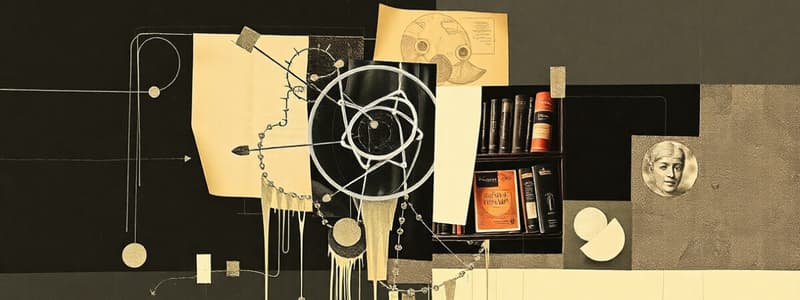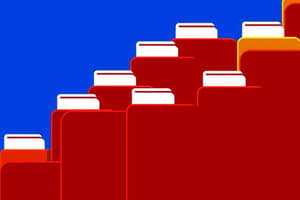Podcast
Questions and Answers
Using the FCFS algorithm, calculate the total distance the disk arm moves starting from cylinder 53 with requests at 98, 183, 37, 122, 14, 124, 65, 67.
Using the FCFS algorithm, calculate the total distance the disk arm moves starting from cylinder 53 with requests at 98, 183, 37, 122, 14, 124, 65, 67.
The total distance is 247 cylinders.
Determine the total distance the disk arm moves using the SSTF algorithm starting from cylinder 63 with requests at 27, 129, 110, 186, 147, 41, 10, 64, 120.
Determine the total distance the disk arm moves using the SSTF algorithm starting from cylinder 63 with requests at 27, 129, 110, 186, 147, 41, 10, 64, 120.
The total distance is 229 cylinders.
For the SCAN scheduling algorithm, how far does the disk arm move starting from cylinder 63 with requests at 27, 129, 110, 186, 147, 41, 10, 64, 120?
For the SCAN scheduling algorithm, how far does the disk arm move starting from cylinder 63 with requests at 27, 129, 110, 186, 147, 41, 10, 64, 120?
The total distance is 239 cylinders.
What is the total distance moved by the disk arm using the FCFS algorithm from cylinder 255 with pending requests including 84, 147, 91, 177, 286, 341, 78, 488?
What is the total distance moved by the disk arm using the FCFS algorithm from cylinder 255 with pending requests including 84, 147, 91, 177, 286, 341, 78, 488?
Calculate the total distance the disk arm moves using SSTF from cylinder 160 with requests at 370, 30, 390, 130, 310, 170, 340, 180.
Calculate the total distance the disk arm moves using SSTF from cylinder 160 with requests at 370, 30, 390, 130, 310, 170, 340, 180.
Using the C-SCAN algorithm, how far does the disk arm move starting from cylinder 63 with requests including 27, 129, 110, 186, 147, 41, 10, 64, 120?
Using the C-SCAN algorithm, how far does the disk arm move starting from cylinder 63 with requests including 27, 129, 110, 186, 147, 41, 10, 64, 120?
What is the total distance the disk arm travels using the SSTF algorithm from cylinder 53 with the request queue of 98, 183, 37, 122, 14, 124, 65, 67?
What is the total distance the disk arm travels using the SSTF algorithm from cylinder 53 with the request queue of 98, 183, 37, 122, 14, 124, 65, 67?
Using the C-SCAN algorithm, determine the distance moved from cylinder 255 with pending requests including 84, 147, 91, 177, 286, 341, 78, 488.
Using the C-SCAN algorithm, determine the distance moved from cylinder 255 with pending requests including 84, 147, 91, 177, 286, 341, 78, 488.
Flashcards
Disk Scheduling Algorithm
Disk Scheduling Algorithm
A technique used to optimize disk head movement to reduce seek time and improve overall disk performance.
FCFS (First Come First Serve)
FCFS (First Come First Serve)
A simple algorithm that processes disk requests in the order they arrive in the queue. It's easy to implement but often inefficient.
SSTF (Shortest Seek Time First)
SSTF (Shortest Seek Time First)
An algorithm that prioritizes requests closest to the current head position. It aims to reduce average seek time.
SCAN (Elevator Algorithm)
SCAN (Elevator Algorithm)
Signup and view all the flashcards
C-SCAN (Circular SCAN)
C-SCAN (Circular SCAN)
Signup and view all the flashcards
File System
File System
Signup and view all the flashcards
Directory
Directory
Signup and view all the flashcards
File
File
Signup and view all the flashcards
Study Notes
I/O Management and File Management
- I/O Management encompasses I/O devices, organization of I/O functions, I/O buffering, hardware organization, and device/disk scheduling policies (FIFO, LIFO, SSTF, SCAN, CSCAN).
- File Management includes file overview, file organization and access, file directories, file sharing, record blocking, secondary storage management, and Android file management.
I/O Devices
- Input/output (I/O) is the collection of interfaces that distinct functional units of an information processing system use for communication.
- Inputs are received signals by a unit, and outputs are signals sent from that unit.
- I/O devices allow people to communicate with computers.
Organization of an I/O function
- Three techniques for performing I/O include programmed I/O, interrupt-driven I/O, and Direct Memory Access (DMA).
- Programmed I/O: The processor issues an I/O command, and waits for the operation to complete, checking I/O module status until completion.
- Interrupt-driven I/O: The processor issues an I/O command, and doesn't wait. The I/O module interrupts the processor when the operation is complete.
- DMA: A DMA module controls data exchange between main memory and an I/O module, without processor intervention.
Categories of I/O
- External devices for I/O are categorized as human readable, machine readable, and communication devices.
- Human readable: suitable for human interaction, such as keyboards, mice, terminals and printers.
- Machine readable: suitable for exchanging data with hardware, such as disk drives, USB keys, sensors, and controllers.
- Communication: suitable for remote device interaction, such as modems and digital line drivers.
Direct Memory Access (DMA)
- DMA is a hardware subsystem that allows certain hardware to access main memory independently of the CPU.
- DMA allows peripheral devices to access the main memory bus directly, which speeds up data transfer.
I/O Buffering
- Buffering is used to effectively handle speed mismatches between data producers and consumers.
- A buffer, stored in main memory, temporarily holds data received from a device such as a modem.
- Data is transferred to a secondary storage device (like a disk) from this buffer in a single operation.
- Buffering minimizes delays due to unequal transfer speeds of different devices.
Types of I/O Buffering
- Single buffer
- Double buffer
- Circular buffer
File Systems in Operating Systems
- Files are named collections of related information on secondary storage.
- File structure is defined by structure characteristics (e.g., bits, bytes, lines, records).
- File types include text, source, object, and executable files.
- File attributes include name, type, location, size, protection, and timestamp.
- Sample file types include video, audio, image, and other executable types (.avi, .acc, .jpg, .apk, etc.).
File Structure
- A field is an elementary data unit
- A record is a collection of related data fields
- A file is a collection of similar records
- Database is a collection of related data
Access Methods for Files
- Sequential access: Reading records one by one sequentially
- Random/Direct access: Ability to access any record without sequential traversal
- Indexed access: Access to data based on a file index, such as a search index that allows jumping to a point rapidly.
Disk Structure
- Magnetic disks are circular plates coated with a magnetized material.
- Plates are stacked on a spindle to form a disk pack.
- Data is stored on tracks and sectors on the surface.
Disk Performance Parameters
- Seek time: Time taken to position the read/write head at the desired track
- Rotational delay/latency: Time to position the desired sector under the head.
- Access time: Total time to access the desired data (seek time + rotational delay)
- Transfer time: Time for data transfer
Disk Scheduling Algorithms
- FCFS (First-Come, First-Served): Processes requests in order received
- SSTF (Shortest Seek Time First): Selects the request with the shortest seek time
- SCAN: Disk arm moves linearly across the disk
- C-SCAN: Linear scan then reverses direction
Studying That Suits You
Use AI to generate personalized quizzes and flashcards to suit your learning preferences.




